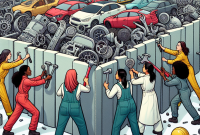
From Classic to Custom: The Art of Restoring Vintage Cars
Restoring vintage cars is not just a hobby; it’s a passion that involves preserving history and craftsmanship. From classic models to custom creations, restoring vintage cars requires skill, dedication, and creativity. In this article, we will explore the various aspects of the art of restoring vintage cars, from the meticulous restoration process to the unique customization options available.
The Restoration Process
Restoring a vintage car involves bringing a vehicle back to its original condition, or even improving upon it. This process can be time-consuming and costly, but for enthusiasts, the end result is well worth the effort. The restoration process typically includes:
- Assessment of the vehicle’s condition
- Stripping the car down to its bare chassis
- Repairing or replacing damaged parts
- Refurbishing the interior and exterior
- Painting or re-finishing the car
- Reassembly and testing
Each step requires attention to detail and a deep understanding of the car’s original design and specifications. Restorers often face challenges in finding authentic parts and materials to maintain the authenticity of the vehicle.
Customization Options
While some enthusiasts prefer to restore vintage cars to their original state, others choose to customize them to suit their personal taste and style. Customization options for vintage cars include:
- Upgraded engines and performance enhancements
- Custom paint jobs and finishes
- Interior modifications such as custom upholstery and audio systems
- Suspension upgrades for improved handling
- Modern conveniences like air conditioning and power windows
Customizing a vintage car allows owners to put their own spin on a classic vehicle while still honoring its heritage. It requires a blend of traditional craftsmanship and modern technology to create a one-of-a-kind automobile.
Case Study: The Ford Mustang
One iconic example of a vintage car that has been both restored and customized is the Ford Mustang. Originally introduced in 1964, the Mustang has undergone numerous transformations over the years. Restorers and customizers often focus on enhancing the Mustang’s performance, appearance, and overall appeal.
From classic restorations that aim to preserve the Mustang’s original design to custom builds that push the boundaries of creativity, the Ford Mustang continues to be a favorite among vintage car enthusiasts.
FAQs
What are some common challenges in restoring vintage cars?
Restoring vintage cars can be challenging due to the scarcity of original parts, the need for specialized knowledge and skills, and the time and financial investment required.
Is it better to restore a vintage car to its original condition or customize it?
It ultimately depends on personal preference. Some enthusiasts prefer the authenticity of a classic restoration, while others enjoy the freedom of customizing a vintage car to their liking.
Conclusion
The art of restoring vintage cars is a labor of love that captures the essence of automotive history and craftsmanship. Whether you choose to restore a classic model to its former glory or customize it to make it your own, the process of bringing a vintage car back to life is a rewarding and fulfilling experience.
From classic to custom, vintage car restoration allows enthusiasts to celebrate the beauty and heritage of these timeless vehicles while showcasing their individuality and creativity. It is a timeless art form that continues to inspire and captivate car lovers around the world.






